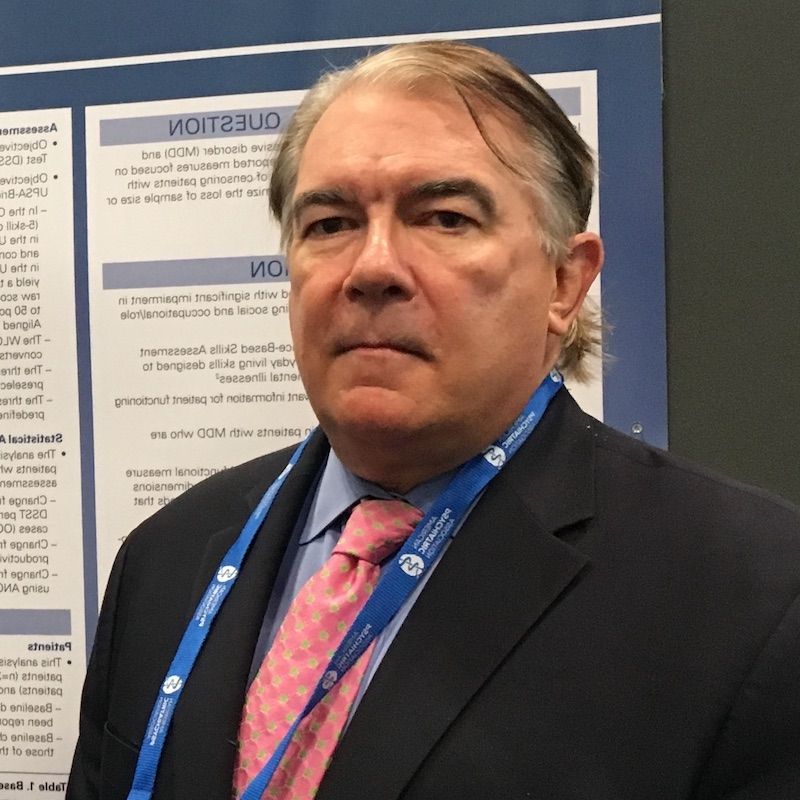Article
Self-Reported Functioning Measures in MDD Patients Identifies Working Patients With Impaired FC
Author(s):
Employed patients who were also impaired on functional capacity measures, showed larger overall treatment response than unemployed patients regardless of functional capacity measure scores.
Philip Harvey, PhD, University of Miami Miller School of Medicine

Philip Harvey, PhD
A recent post hoc analysis presented at the American Psychiatric Association’s Annual Meeting concluded that working patients who scored higher on functional capacity measures showed larger overall treatment responses than non-working patients regardless of scores on functional capacity measures in treatment of major depressive disorder (MDD).
Researchers from the University of Miami Miller School of Medicine aimed to screen for patients with MDD and impairments in functional capacity through self-reported measures that focused on everyday outcomes; a strategy that could bypass risk of censoring patients with higher functional capacity measures.
“Using a performance-based functional capacity measure to select patients entails 2 challenges,” study authors, said. “First, it is not known how many cases with high functional capacity scores would need to be censored. Second, the possibility of bias with sites influencing baseline functional capacity scores can damage the integrity of the study.”
In the analysis, researchers studied the use of self-reported functional measure, the Work Limitations Questionnaire (WLQ), to identify patients with greater impairments on functional capacity. Responses were evaluated to treatment on cognitive measures.
CONNECT, a phase 3 placebo-controlled active-referenced (duloxetine) clinical study, evaluated the effects of vortioxetine on cognitive function in adults with MDD. The University of California San Diego Performance-Based Skills Assessment (UPSA) was included as a predefined endpoint, and 0.9% (n=5) patients scored at ceiling (score of 100) at baseline. Patients with high UPSA baseline scores, however, have limited to no room to demonstrate improvement and achieve responder status, which necessitates excluding patients with higher baseline UPSA scores from future trials to evaluate cognition in MDD. Additionally, the WLQ was performed in a subset of working patients (41.4%) and neither vortioxetine nor duloxetine demonstrated clinical efficacy on the WLQ sensitivity index with statistical significance.
Retrospective post hoc analyses of data from the CONNECT study was intended to examine if WLQ can be used instead of the UPSA to identify working patients for studies evaluating cognition in MDD and to exclude those who are likely to achieve ceiling scores on the UPSA.
In this post hoc analysis, working patients were defined as those 18—65 years of age who met the DSM-IV-TR diagnosis of MDD. Patients had moderate to severe depression, with a Montgomery-Asberg Depression Rating Scale (MADRS) total score of ≥26 at screening and baseline, and a duration of at least 3 months for current major depressive episode.
The analysis included 528 patients with moderate to severe MDD and a subset of patients (n= 207) who were employed at least 14 days before baseline and completed the WLQ.
In the large-scale depression trial, 528 patients were examined with the University of California San Diego Performance-Based Skills Assessment (UPSA) VIM and Brief Versions, Digital Symbol Substitution Test (DSST), among other clinical measures. UPSA-B aligned scores were derived from both VIM and Brief versions. There were 3 arms: vortioxetine 10—20 mg/d, duloxetine 60 mg/d and placebo.
The score distributions on the UPSA-B were examined in terms of baseline scores and treatment response, as a function of employment status and scores on the WLQ in employed patients.
Employed patients had higher UPSA-B scores at baseline, versus unemployed patients (80 versus 77). Among employed patients, scores of ≥13 on the WLQ—with higher scores reflecting more impairment—were associated with greater impairment on the UPSA-B (78 versus 82).
Patients with greater impairments on the WLQ showed larger treatment-related improvements on the UPSA-B—a 5.4-point improvement on vortioxetine relative to placebo (P <0.05), while patients with lower impairments on WLQ had a 1.8-point improvement (P >0.05) on the UPSA-B.
Additionally, patients with higher scores on the UPSA-B (85 or higher) at baseline had lower overall improvement on the WLQ with treatment, versus those with <85 scores on baseline—UPSA-B, 0.05- versus 1.1-point improvement.
Findings concluded that employed patients with depression, who have lower levels of disability at baseline, may need additional screening in order to determine whether or not they will manifest ceiling effects on critical functional capacity outcomes.
The retrospective, post hoc analyses of CONNECT, showed that among working patients with depression, a self-reported measure of workplace productivity can identify those with lower performance-based functional capacity.
Including patients with WLQ scores >13 may reduce the need for censoring patients because of ceiling effects on functional capacity measure—overcoming potential study power loss. The WLQ cut-off score of 13 aided in identifying patients with higher impairments in Digit Symbol Substitution Test (DSST) scores who also showed larger improvements with vortioxetine treatment.
Additionally, employed patients who were also impaired on functional capacity measures showed larger overall treatment response than unemployed patients regardless of functional capacity measure scores.
Limited conclusions may be drawn from the study, however, due to the small sample size and use of post hoc analysis.
Click here to sign up for more MD Magazine content and updates.
Related Coverage >>>
David Walling, PhD: Aripiprazole Lauroxil NanoCrystal Dispersion for Schizophrenia
APA Announces New Guidelines for Pharmacological Treatment of Alcohol Use Disorder
Could Pokemon GO, Augmented Reality Apps be Used for Mental Health Therapy?




